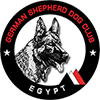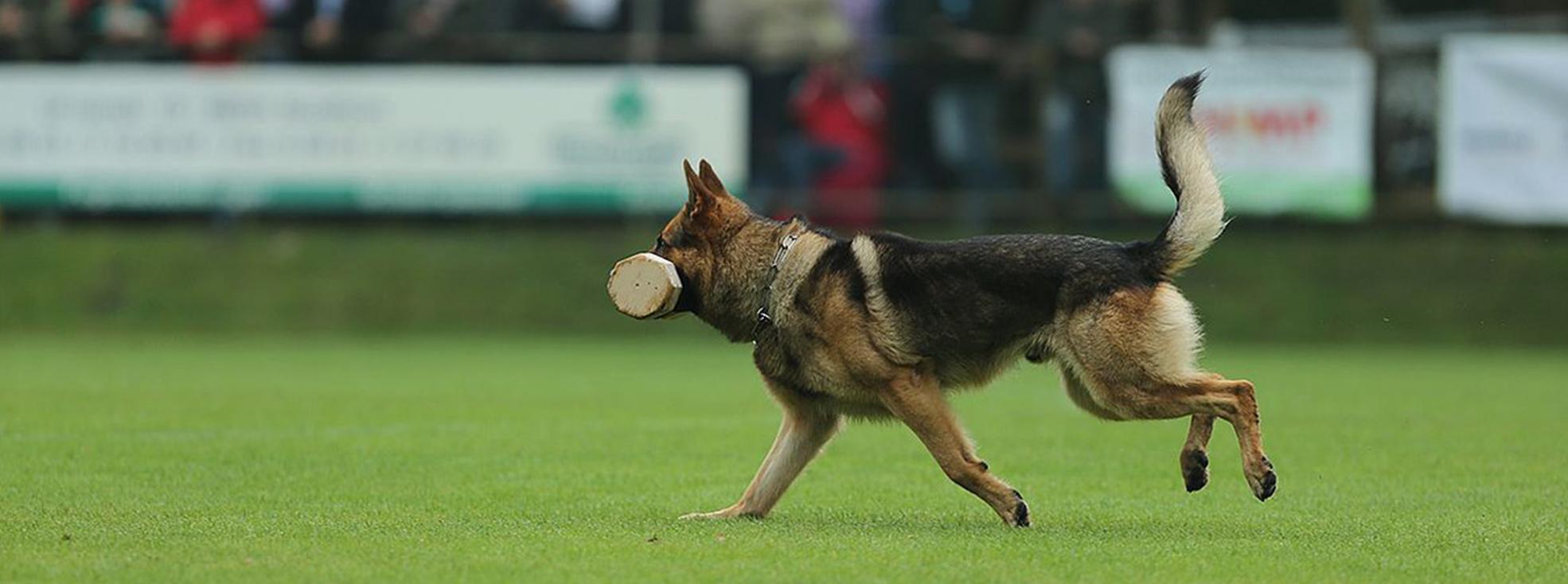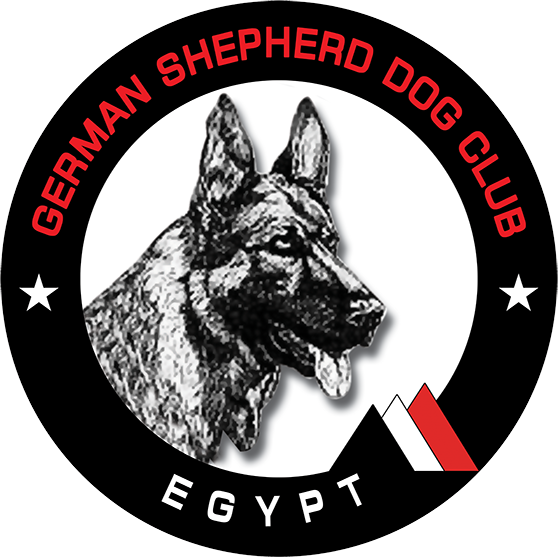IGP
IGP Internationale Gebrauchshunde Prüfung
IGP is a German word meaning “Internationale Gebrauchshunde Prüfung". It refers to a sport that focuses on developing and evaluating those traits in dogs that make them more useful and happier companions to their owners.
IGP started at the beginning of this century as a test for working dogs. Its initial purpose was to determine which dogs could be used for breeding and which had true working ability. The growing demand for working dogs made more sophisticated tests and training necessary. These dogs were needed for police training, border patrol, customs, military, and herding. As these tests evolved, more people participated just for the sheer enjoyment of seeing if their personal dogs could be trained as effectively as these "performance dogs". IGP is a dog training and breeding regimen developed originally by Deutsches Shaeferhund Verein (German Shepherd Dog Club), or SV, in order to maintain the working ability of the breed. This breed evaluation test was originally developed specifically for the German Shepherd Dog.
The first IGP trial was held in Germany in 1901. Many countries and working dog organizations have also adopted IGP as a sport and test of working performance. International rules have been established by the Verein fuer Deutsche Hundesport (VDH). Many breeds now participate in addition to German Shepherd Dogs. While there may be individual dogs of a particular breed that may be suitable for the work, the following are most consistently able to perform: German Shepherd, Belgium Malinois, Doberman Pinscher, Bouvier des Flanders, Rottweiler, Tervuren, Boxer, Giant Schnauzer, etc. Generally, these are larger working breeds with strong prey and defensive drives, and temperament suitable for the tasks of the training. While the term IGP means literally "protection dog". The training involves work equally in Tracking, Obedience and Protection. In order to get a IGP degree a dog must pass all three phases of the work. Only dogs that appear healthy can be exhibited in a trial. Before being permitted to participate in a trial, each dog must pass a test of impartiality and sureness. The testing is performed prior to the Tracking phase which is the first phase of the trial. Testing of the self-confidence will take place during the entire trial. Dogs who fail of the self-confidence or impartiality are to be excused from the trial proceedings. Before any dog can enter a IGP trial and obtain a degree it must pass a ( BH ) . BH = German Companion Dog. The dog must pass this test at an approved IGP Trial. This test was developed as a preliminary character evaluation. This test was designed to keep aggressive, sharp, shy, or nervous dogs from participating in the sport. A dog must have absolutely sound temperament to compete in an IPO trial.
There are three major degrees awarded: IGP1, IPGP, and IGP3 - in order of increasing difficulty. The traits that make for a good IGP candidate mostly are innate characteristics that must be bred for. Even among dogs bred out of IGP bitches and dogs, a minority have the ability to reach even IGP1, and a small percentage will have the necessary drive, intelligence and hardness to achieve a IGP3 title. The above degrees were difficult enough, but to make it even more demanding, they all happen in one day during competitions that are held all over the country. These trials are held by local clubs or in regional and national championships. Each dog is judged by a complex point system that then determines the winner of the trial. IGP training is very time consuming and requires a lot of commitment from the handler. The length of time it takes to get a IGP title varies greatly depending upon the dogs abilities, the time spent training, and the quality of the training. This working dog sport offers an opportunity for dog owners to train their dog and compete with each other for recognition of both the handler's ability to train and the dog's ability to perform as required. IGP as a sport is enjoyed by persons of varied ages, professions and life styles. IGP is an active sport that has a lot to offer. It's held outdoors. It's a physical sport. It's mentally stimulating. IGP is a demanding recreational sport that is both fun and very rewarding.
Degree Levels - Minimum Age Requirements
BH 15 months
IGP 1 18 months
IGP 2 19 months
IGP 3 20 months
Ratings and Point Scores
U - Unsatisfactory 0 - 109 points
I - Insufficient 110 - 219 points
S - Satisfactory 220 - 239 points
G - Good 240 - 269 points
SG- Very Good 270 - 285 points
V - Excellent 286 - 300 points
Awards for Combativeness including Courage and Hardness are:
P - Pronounced ( Ausgepraegt )
S - Satisfactory ( Vorhanden )
I - Insufficient ( Nicht Genugend )
Tracking
Requires the dog to meticulously follow a person's footsteps over mixed terrain, change direction and show absolute accuracy and commitment to finding the track. It must also find dropped articles with human scent and indicate their location to the handler. Often this is done under less than ideal circumstances with difficult ground cover, bad weather conditions and an aged track. Many find tracking to be the most satisfying experience in training, when only the handler and dog are working together.
Obedience
will feel more comfortable in this area, as many of the exercises are similar. There is heeling, both on and off lead. The sit, down and stay are also done when the dog is moving. IGP applies its own style to the work. The handler and dog work on a soccer size trial field. Some exercises require the dog to heal under the noise of a firing gun. In addition to the normal dumbbell retrieval, the dog must retrieve over several obstacles with varying degrees of difficulty. Down stays and a long send away conclude the test. When the IGP dog is working he should exhibit willingness and enjoyment. The dog should perform the exercises quickly, with spirit and precision. Each exercise should be taught to the dog to create the desire to work in the dog. Dogs that are slow or dull during the work are penalized heavily by the judge. Obedience training also carries a moral burden for the trainer of a dog who is also receiving protection training. It is necessary that the dog be reliable and under control in all situations. To be a safe companion, the dog must master walking at his master's side, lying down and staying on command in any location at any time.
Protection
Training is grossly misunderstood by the general public! A misconception regarding protection training is associating it with guard dog or attack training. Nothing could be further from the truth! The most important point to understand when watching a protection routine is the relationship between dog and handler. The dog must never bite the trial helper unless either dog or the handler is attacked. Then it must attack fully and without hesitation. Here the real difference between IGP and guard dog - attack training becomes apparent. The dog must stop biting on the command of the handler and guard the trial helper without further aggression. The IGP dog must always be under the absolute control of the handler. The IGP dog must be friendly and approachable. It does not regard a person as an enemy until the person displays signs of hostility or aggression towards him or his handler. The IPO dog is trained with love, he and his master work together as a team. The IGP dog is not a nuisance or danger to society. They should never be put in the same category as an attack dog. A final misconception involves the feeling that a dog will protect his owner "when the chips are down". Most family dogs have been taught not to show any aggression. In addition many do not have the courage to bite when threatened. An untrained dog is an unpredictable dog. The IGP dog who has had formal protection training is predictable, therefore an asset to his owner and to the community. A well trained, reliable dog can serve for many years as a family protector and companion. To many competitors this is a family sport. Children are often seen playing with their dogs before and after the dog leaves the protection field. This seems impossible to the uneducated, but this is a product of good breeding and proper training. IGP dogs are by far the most predictable, trustworthy, and safe animals to be around.
Agility
Jumps
Teaching correct jumping and wall scaling technique is important for the safety of the dog as well as points. A young dog should not start formal jumping until he is fully co-ordinated around 1 year to 18 months of age, although a couple of low jumps as a puppy will not hurt. I begin by setting my solid IGP jump at the height just above the dogs knee. This height will not tip him over onto his face if he knocks it, but by starting over a solid jump, he learns to clear the jump, since it will not fall if he knocks it. I gradually work up to around shoulder / wither height. At this point I begin working the dog over PVC agility jumps at around 24" for a German shepherd. At this point it is important that the jump can fall if the dog judges a stride wrong. I use a ball or food for reward and only reward if the dog jumps the whole set cleanly. Once the dog is jumping confidently and arching nicely over the sequences, I add the retrieve to a single jump of 24". It is important that the retrieve has been fully taught by this point so the dog understands that reward will be withheld for not jumping in one direction. To begin with, you can practice next to a fence on one side with wings or barriers on the other so that it is easy for the dog to get the exercise right, and then begin removing the props. I move up gradually to the full size IGP jump around a month before the trial. It is important that the dog jumps this height, or even a few inches higher as they acquire muscle memory for that height, and if you routinely jump lower than full height, you will find that the dog knocks the jump at the trial.
Walls
Teaching the wall can begin when the dog is a puppy, set it no more than 3 feet from the ground at the highest point, and guide him over with a leash, ball or food, be sure to get excited and play afterwards. Gradually raise the wall as the pup gets more confident. Puppies can also learn much of the agility equipment. This helps raise awareness of their back legs and helps build confidence. Quite a few agility clubs offer a puppy class which many handlers and their dogs enjoy. Once the pup is big and strong enough, you can raise the wall to regulation height. It is important for his own safety that the dog does not learn to fly off the top. One way to teach this, is to teach him to target his nose on a piece of transparent plastic, then place that plastic at the foot of the wall. Give your targeting command as the dog comes towards the clear plastic, and have him stop with his hind legs still on the wall before feeding him on the plastic and releasing.
Harness
While not essential, different harnesses can be used for tracking and protection depending on handler preference. For protection training, a sturdy harness makes holding the dog much easier since you are holding him near his centre of mass. Dogs which are large and strong, small dogs, unco-ordinated pups and dogs who drop the sleeve when there is pressure on the collar all benefit from working in a harness. Generally though, it is a matter of personal preference. The harness should be snug so the dog cannot wriggle out of it, but you should be able to slide your hand underneath it. It should have a strong D ring on the top of the dog's back to attach the lines. Bottcher harnesses are specialist tracking harnesses and are allowed in trials. The design is supposed to help keep the dog's head down. It is also useful for dogs who tend to rush while tracking. The harness can also be put on upside-down across the dogs back to help with stand training.
Lines & Leashes
The two most important lines are the short standard leash and the 33 foot tracking line. These are the leashes that will be required when you trial your dog. The short leash must hang loosely, and should be small enough to conceal or be able to be carried over the shoulder (top left to bottom right). My preference for the short leash is 5/8 inch wide, 3 foot long leather and I use this leash for training and trialing. For the tracking line it is important that the line be light, and non-slip. It is made of Biothane and doesn't get clogged with dirt or heavy when it is wet, and it does not slip through my hands. Biothane is widely available at various online stores and tack shops. For tracking training and protection, I use 2 x 15 foot nylon lines. They are made of tubular nylon so they do not burn my hands. In tracking, I attach them several links apart and place them, one under each foreleg, this allows me to help steer a novice dog. In protection, I connect a line to the prong collar and a line to the fursaver/wide collar/harness. As far as general purpose walking leashes, my favorites are the 6 foot cotton horse leads which I buy in the UK. I also have several other lengths of tubular nylon line and a 6 foot leather leash for showing.
Fur Saver
A fur saver is usually one of the first items obtained by a IGP enthusiast. It is the same style as a standard choke collar where the links are dropped through one of the end rings, making a loop which is slipped over the dog's head. They are rarely used for their choking action, and are the usual collar for trials, since the dog is not supposed to wear any kind of flat collar or other training collar. When the leash is attached in trials, it is usually to the "dead ring". This completely by-passes the choking action. These collars can be made of chrome plated nickel, steel, copper, brass and I have seen other metals and alloys too. I use fur savers extensively for tracking young dogs. I track with two lines so I can help the dog with the left - right motion of following the steps. Each line is placed under each of the dogs front legs and attached to the fur saver with three open links between. This helps more with steering than having the lines attached to the same ring. When buying a fur saver, a puppy around 4-6 months should fit a 17 - 19". A cheaper chrome plated one will be fine for this purpose, most last around 3 years, more if you carefully dry them off when they get wet. Most females will not require anything larger than 21 - 23". Large males may require 25" or even more.
Dumbbells
IGP has specific dumbbell requirements for each level of title. These regulations are based on weight.
IGP1* - 650g
IGP2 - 1000g
IGP3 - 2000g
* In all cases the IGP1 dumbbell is used for the retrieve over the jump.
When training the retrieve, any dumbbell can be used. A wooden dumbbell proportionate to the dog's size is nice for training. In order to extend it's useful life and also to provide some grip and give/softness to the mouthpiece of the dumbbell, a wrap of some kind can be used. My favorite is vet-wrap because it is easy to apply as it sticks to itself and can be wrapped several times to provide good thickness and give. When it gets really slimy, just cut it off and apply a new length.
Articles
Articles for tracking generally include wood, leather, plastic, carpet. IGP regulations specify specific sizes for trialing. These are 10cm (4 inches) long by 2-3cm (¾ inches to 1¼ inches) wide by 0.5-1cm (3/8 inches to 5/8 inches) thick. When training young dogs, a material which holds scent well, such as leather, makes a good starting article, preferably around double the regulation size. If you begin by training the articles off the track with a clicker, use the opportunity to introduce all sizes and materials but be sure to scent them well.



